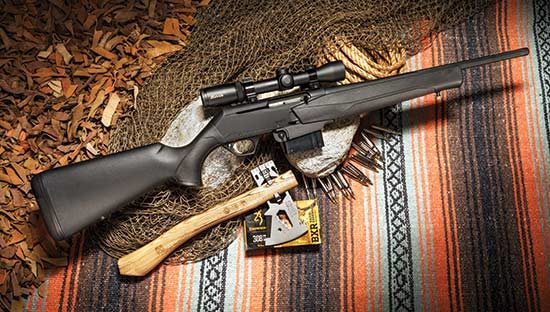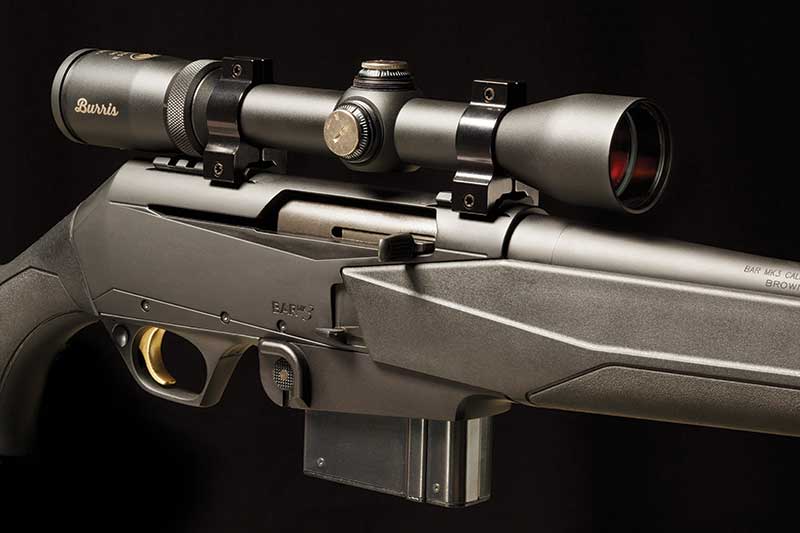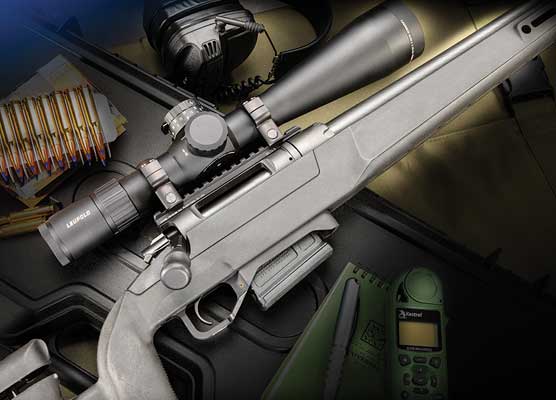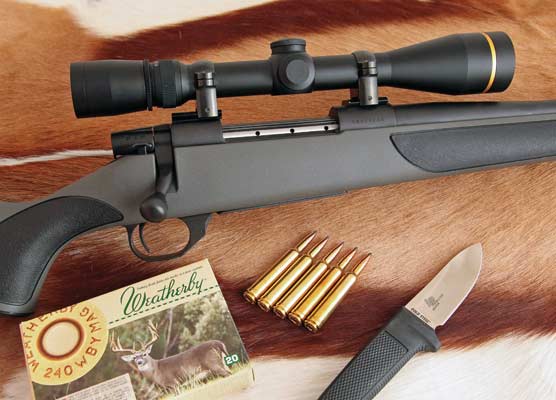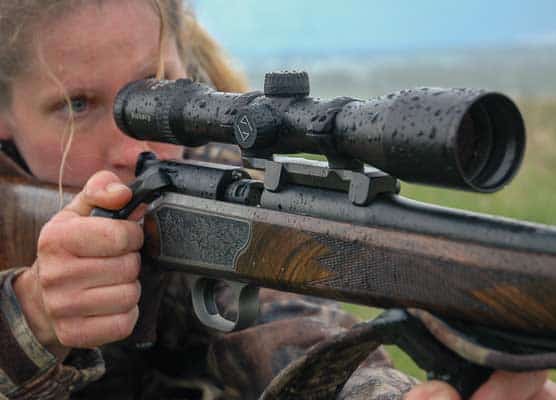Setting The Bar
Browning’s Mark 3 DBM Makes For One Great .308
When I began shooting centerfire hunting rifles on a regular basis, it was practically an article of faith an autoloader simply couldn’t hang with bolt guns when it came to accuracy.
But what made me question this bit of wisdom many years ago was when I was asked to check the zero on the late Robert E. Petersen’s pet “ranch rifle.” Pete, as many shooters may know, had the means to acquire literally any shoulder-mounted firearm made (for any purpose) that caught his fancy.
The rifle in question was his Browning Grade 1 BAR sporter in .243 Winchester. If I remember right, the load was Federal Premium 100-grain, which served double duty on deer and coyotes. What I do recall with clarity, however, was this rifle was a tackdriver—delivering 1-inch (or less) 3-shot groups 1-1/2 inches high at 100 yards with boring regularity. All this without the indignity of having to manually cycle each round!
Up to then, my sole experiences with self-loading rifles had been limited to Remington’s Model 742, Winchester’s Model 100, the HK Model 770 and, of course, Colt’s original AR-15 in civilian-legal “sporting” trim. As far as I saw, the BAR outshot them all except, possibly, the roller-locking HK.
But after I was done having fun with Pete’s BAR, I promptly forgot about it. By the mid to late 1980’s, the tide of military-type autoloaders had pretty much taken over—AR’s of course, plus AK’s, Valmets, dirt-cheap SKS carbines, ultra-pricey SIG Stgw. 57’s, HK 91’s and 93’s, FN FAL’s. In short, virtually everything imaginable with a battlefield pedigree and stateside distributor.
Some are here, some have gone, but the BAR remains. It’s gone through various grades, iterations and calibers (up to .338 Win Mag even).
Recently we got our hands on an updated version of the BAR, the Mark 3 DBM with an 18-inch hammer-forged barrel, multi-lug rotary bolt, .308 chambering, black synthetic furniture and integral Weaver rail sections on board the receiver.
It appears to be an offshoot of the company’s discontinued BAR ShortTrac Hog Stalker concept, except it doesn’t have a RealTree camo dip, interchangeable cheekpieces, 20-inch barrel or bottom light rail. No matter as far as I’m concerned. The DBM may lack the bells and whistles of the Hog Stalker, but it appeals to me more with its “basic black” simplicity.
The “DBM” incidentally, stands for “Detachable Box Magazine.” It’s a 10-rounder. And I like it because I’ve always been less then thrilled with the hinged-floorplate “compromise” detachable magazine on most other Browning rifles. The first time I used a bolt-action Browning A-Bolt in the field, the relatively complex “swing down, slide off, reload” aspect drove me crazy trying to figure out.
I can see the appeal of wanting a traditional flush-floorplate look to avoid any possible aesthetic embarrassment of being seen with a conventional detachable mag. But I used a Remington Model 788 for years, and detachable box mags don’t bother me a bit, even on a straight-ahead “non-AR” hunting rifle.
At any rate the DBM’s industrial strength, sleeved mag well, sculpted triggerguard and black synthethic furniture give it a chunky all-business look I find appealing. Kind of like an old Remington Model 8 autoloader, except sleeker and seriously sculpted. The magazine release—at the rear of the magazine sleeve, just forward of the triggerguard—is large and easy to access. The overall length, incidentally, is a hair over 40 inches—handy indeed (and only 2 inches longer than Winchester’s Model 94 Carbine).
First off, we took advantage of the Mark 3 DBM’s two integral rail sections to mount a Burris Fullfield 2-7X variable on it. We’ve used them The 2X low end is ideal for fast-breaking hunting situations and the 7X high end provides all the magnification you’re probably ever going to need on a .308 sporting carbine. This setup could be a hog gun and a half.
The 18-inch barrel seems to be a pretty good “sporting” compromise between a blasty 16-inch barrel and the slightly more ballistically efficient 20 inches. But like any carbine-length .308, this is a pretty noisy item. The alloy receiver and composite stock add up to a 6-pound, 10-ounce curb weight.
The trigger on our test sample was excellent by just about any action standard and broke at a crisp, consistent 2-1/2 pounds as dutifully recorded by our communal Brownells gauge. Without a doubt, it’s the softest-shooting .308 in its weight class I’ve ever used. I let three other shooters try it and they agreed with me. One of them, an inveterate “stock crawler” wanted to buy it off me on the spot until I explained the ownership situation. As far as a sporting autoloader goes, this has got to be at—or very near—the top of the heap.
The ammo menu we picked out for the BAR ranged from 150 to 178 grains, the rifle exhibiting a preference for stuff in the 150- to 168-grain range. But it shot pretty well with everything. And here’s a pretty good tribute to the consistency of the loads we selected: The average extreme spread of everything we shot was a measly 37 fps. Granted, we were using premium stuff, but that’s a pretty impressive spread. So maybe next time we’re messing with a .308 we’ll try to toss in a couple of price brands!
The three most impressive performers out of the Mark 3 DBM turned out to be Black Hills 168-grain A-Max, Federal 150-grain Trophy Copper, and the “house brand” 155-grain Browning BXR, a polymer-tipped item with a nickel plated case that’s part of the company’s burgeoning line of proprietary ammo.
We tried to avoid heating the barrel up too much, although it did get pretty warm for a while, groups didn’t seem to open up all that much. There are a lot of opinions as to whether fluted barrels are stiffer and dissipate heat better than non-fluted ones. I’d be inclined to agree with those who think fluted barrels do a better job of throwing off heat than a regular barrel of the same contour. But as a hunting rifle, it’s unlikely you’re going to be ripping off a full magazine with it regardless.
The Mark 3 DBM, incidentally, was quite kind to brass—which showed no serious signs of abuse. Not trusting totally to memory, I checked with my shooting buddy, Thomas Mackie (who kept the empties) for confirmation on this point. “Nah, no mangling at all. It was sweet all the way around.” Ejection was positive and consistent as far as the “empty landing zone” went.
In short, this new-edition BAR was every bit as accurate (probably more so) than the one I shot so many years ago. If I’d have seen this particular rifle back then, a younger, trendier, more caliber-conscious me would have wished aloud for a couple of chambering options besides .308.
But even now, however, I occasionally catch myself speculating over one in .338 Federal topped with an Aimpoint Micro. Talk about a tool for one of those East European driven boar hunts! But idle daydreaming aside, right now I think it’s ideal as is. Our .30-caliber service round is about perfect for this platform, and this platform seems about perfect for it.
Homage to History
Although they share the same legendary acronym, Browning’s BAR sporter is a separate rifle from the military Browing Automatic Rifle M1918, which really put the auto in “Automatic.” According to the company’s A Brief History of the Browning BAR, it came about as follows:
“Its design is the result of Browning’s unmatched understanding and expertise with automatic rifles that started with John M. Browning. His grandson, Bruce Browning, was the driving force behind today’s BAR. A large team of automatic firearms experts at the FN factory in Belgium also played a key role in its development. This group of FN automatic rifle designers, led by Marcel Olinger, began serious work on the project code named “Carbine 66,” with full-scale development and testing done throughout 1966 in preparation for an official 1967 product launch.”
Since then, the BAR has gone through many variants. In 2017, besides the no-nonsense Mark 3 DBM, the company also introduced something a bit more upscale. The BAR Safari 100th Anniversary, which marks the milestone centennial since the introduction of the legendary BAR M1918, which was a go-to source for portable infantry firepower in WWII and Korea and beyond.
